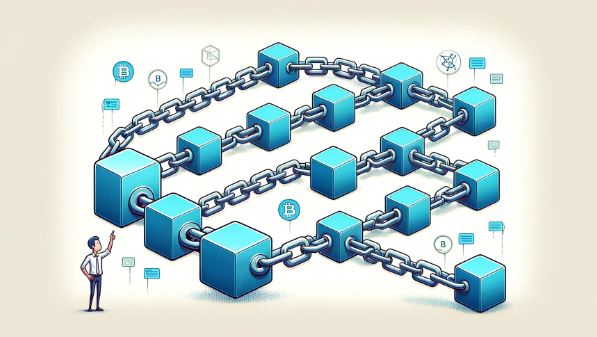Back in 1991, when the internet itself was in its infancy, two brainy guys, Stuart Haber and W. Scott Stornetta, came up with something neat. A digital ledger technology where every piece of data is sealed so tightly that it can’t be tampered with later. Why, you ask? Because in this digital age, there’s a whole lot of fakery around.
Whether it’s a legal contract or a research paper, its authenticity has to be proven. Enter the world of the emerging technology called blockchain: a super-secure method the likes of which we’ve rarely seen before. You are at the best place, because here the blockchain technology explained deeply.
The Financial Crisis and Bitcoin
How could the tale of Bitcoin and blockchain have started with more drama than a global financial meltdown? In 2008, economies around the world crumbled, and that’s when a shadowy figure stepped onto the stage: Satoshi Nakamoto.
He unleashed the Bitcoin whitepaper, the blueprint for a decentralized, tamper-proof digital currency. So, Bitcoin is like a phoenix rising from the ashes of the financial crisis, sparking the entire blockchain revolution.
History of Blockchain Technology
The history of blockchain goes back to 1982 when cryptographer David Chaum introduced a concept resembling blockchain in his dissertation titled “Computer Systems Established, Maintained, and Trusted by Mutually Suspicious Groups.”
Fast forward to 1991, and we see Stuart Haber and W. Scott Stornetta pioneering the idea of a cryptographically secured chain of blocks to prevent tampering with document timestamps. This concept what we now know as blockchain technology.

In 1992, Haber, Stornetta, and Dave Bayer took a significant step by incorporating Merkle trees into their design. This enhancement greatly improved efficiency by allowing multiple document certificates to be grouped into a single block.
Under their company Surety, they even began publishing document certificate hashes in The New York Times, demonstrating the real-world potential of use blockchain technology as early as 1995.
The big “aha” moment in blockchain history came in 2008 when an individual or group using the pseudonym Satoshi Nakamoto introduced the concept of a decentralized blockchain. Nakamoto’s brilliant innovation was to use a Hashcash-like method for timestamping blocks without relying on a trusted intermediary.
Satoshi also introduced a difficulty parameter to ensure a stable rate of block addition. These ideas were the ones behind the most famous cryptocurrency what we call Bitcoin.
By August 2014, the Bitcoin’s public blockchain network had accumulated a substantial file size of 20 GB, containing records of all network transactions. The size continued to grow, reaching almost 30 GB by January 2015 and a staggering 100 GB by January 2017. In early 2020, the ledger size exceeded 200 GB, highlighting the extensive usage and adoption of blockchain technology.
The term “blockchain” itself evolved from Satoshi Nakamoto’s original paper. Initially, he used the words “block” and “chain” separately, but by 2016, they had become widely popularized as a single word, “blockchain.”
How Does Blockchain Work – Blockchain Technology Explained
Blockchain is a distributed database essentially, but not a traditional database in the usual sense. Blockchain is made up of a sequence of “blocks,” each of which has transactional data. These blocks form a chain to guarantee the integrity and authenticity of the data.
The integrity of the data is secured using “hash” functions. It’s a mathematical algorithm that can transform any size of data into a short and unique sequence of characters. When a new block is added to the blockchain, it also contains the hash value of the previous block, creating a verifiable and immutable chain.
If someone tries to modify the data in an existing block, the hash value changes, which is immediately visible in the rest of the chain. This allows other participants to quickly detect any manipulation.
One of the most innovative aspects of blockchain technology is that almost anyone can join the verification process. There is no need for a central institution or organization to oversee the data; the community itself performs this role. This is called decentralization.
The significant advantages of a decentralized system is that it is much harder to hack or manipulate because the data is not stored on a single central server but on various machines worldwide. In addition, it provides the opportunity for cryptocurrencies and other digital assets to be managed not just by large financial institutions.
Different Types of Blockchain Networks
There are various types of blockchain networks, each with its unique characteristics. Open blockchains, known for their openness, offer a more user-friendly approach compared to traditional ownership records, even if they are open to the public.
However, an ongoing debate questions whether private systems with authorized verifiers, appointed by a central authority, should be considered blockchains. Supporters of permissioned or private chains argue that any data structure that organizes information into time-stamped blocks could be labeled as a blockchain.
The systems using this technology serve as distributed versions of multiversion concurrency control in databases, ensuring data consistency. Opponents argue that permissioned systems resemble traditional corporate databases, lack decentralized data verification, and are vulnerable to operator tampering.
In contrast, permissionless, or public, blockchains like Bitcoin operate without the need for access control or trust among participants. This open nature allows applications to be added to the network without approval from others, using the blockchain as a service, as a secure transport layer.
Bitcoin and many other cryptocurrencies employ open blockchains, securing them with proof of work mechanisms and cryptographic puzzles. In 2016, venture capital investment for blockchain-related projects surged in China while weakening in the USA. Bitcoin, as of April 2018, maintained its status as the cryptocurrency with the highest market capitalization.
Permissioned, or private, blockchains introduce an access control layer that regulates network access. These blockchains have been argued to offer a certain degree of decentralization when thoughtfully designed, contrasting with the often centralized nature of permissionless blockchains in practice.
Certainly, here are some pros and cons of open, permissionless (public) blockchains and permissioned (private) blockchains.
The Public Blockchain – Open and Permissionless
Just like any technology, blockchain also has its own pros and cons. In this part, check how the public and closed blockchains differentiate through their own benefits and backwards. Let’s start with public ones, that are accessible for anyone.
Pros:
- Decentralization: Public blockchains are truly decentralized, as they operate on a global network of nodes with no central authority. This enhances trust and security.
- Transparency: All transactions and data are visible to anyone on the network, ensuring transparency and reducing the risk of fraud.
- Censorship Resistance: Public blockchains are resistant to censorship, making them ideal for applications where freedom of information is crucial.
- Innovation: Public blockchains encourage innovation by allowing anyone to participate and develop applications on the network.
- Security: The security of public blockchains is enhanced by their vast network, making them highly resilient to attacks.
Cons:
- Scalability: Some public blockchains struggle with scalability issues, causing slow transaction processing times and high fees.
- Lack of Privacy: Complete transparency can be a drawback in situations where privacy is paramount, as all transactions are visible to everyone.
- Resource-Intensive: Public blockchains require significant computational power and energy, which can be environmentally taxing.
- Security Concerns: While highly secure, public blockchains are not immune to vulnerabilities, and the irreversibility of transactions can lead to risks.
- Regulatory Challenges: The openness of public blockchains can pose regulatory challenges in some jurisdictions.

Closed and Permissioned Private Blockchains
Now continue with closed ones.
Pros:
- Control: Organizations have greater control over who participates in the private blockchain network, which can enhance trust and security.
- Efficiency: Permissioned blockchains often have faster transaction processing times and lower fees due to reduced competition for network resources.
- Privacy: Data on permissioned blockchain systems can be kept private, making them suitable for sensitive applications.
- Regulatory Compliance: These blockchains can be designed to comply with specific regulations, reducing legal risks.
- Lower Energy Consumption: Permissioned blockchains typically consume less energy compared to their public counterparts.
Cons:
- Centralization: Permissioned blockchains are inherently more centralized, which can lead to trust issues and the risk of a single point of failure.
- Limited Innovation: Restricted access can limit innovation and collaboration, as only authorized participants can contribute.
- Cost: Developing and maintaining a permissioned blockchain can be expensive, particularly in terms of governance and infrastructure.
- Reduced Security: While more controlled, permissioned blockchains may still face security vulnerabilities, especially if the validating nodes are not well-secured.
- Dependence on Central Authority: Permissioned blockchains often rely on a central authority or consortium to govern and maintain the network, which may not align with the principles of decentralized nature of blockchain.
The choice between open, permissionless blockchains and permissioned blockchains depends on the specific use case and the desired balance between decentralization, control, and privacy.
Use Cases on Blockchain Network
Until now we have understood how this technology works. We know how they differentiate and what are their benefits and backwards. Let’s see the next part, where we provide real use cases about the technology.
Smart Contracts
One of the most exciting use cases of blockchain technology is smart contracts. Imagine no longer having to go to expensive lawyers to create or enforce a contract. Smart contracts are automated and execute the contract all by themselves once pre-defined conditions are met.
Smart contracts were introduced by the man called Vitalik Buterin, founder of one of the biggest cryptocurrency called Ethereum, runs on Ethereum blockchain system.

Buterin’s innovation allowed developers to create decentralized applications (DApps) that automatically execute these contracts when predefined conditions are met.
Using smart contracts eliminating the need for third parties and offering transparency and security in various fields, including finance, supply chain management, and more.
Blockchain as the Most Reliable Diary
One of the key features of blockchain is that transactions are traceable and immutable. If someone tried to change an existing blockchain transaction, it would become immediately obvious and the whole system would collapse. Say, if you tried to remove one domino from the queue, all the others would be dropped.
This means that the blockchain is an extremely secure and reliable database. In the financial world, where data integrity is key, the use of blockchain could revolutionize the way transactions are tracked and legal liability is determined.
Transaction Speed
When someone uses fiat currency to make a transfer, it can take time, sometimes days. However, blockchain transactions often take minutes or even seconds, depending on which blockchain is used. The speed usually depends on the transaction fee and the network load. For example, on the Ethereum network, the “Gas” fee determines how fast a transaction is processed. Higher Gas fee = faster transaction. This is important because businesses need fast, cheap and efficient solutions.
The Validation Process
Probably one of the most important element of blockchain technology is validation. Once a transaction enters the network, the “miners” or validators start checking it. This process involves solving a number of mathematical problems, which is not only time-consuming but also requires considerable computing power.
Once the transaction is real and the puzzles are solved, it is inserted into the blockchain. This complex verification process is what makes the blockchain so reliable and tamper-proof.
Security
When we talk about security in the blockchain world, we are talking about two types of keys: public and private. The public key is visible to others and can be used to make references, while the private key is known only to the owner and allows transactions to be approved. Think of it like a mailbox, where the address is the public key that anyone can send mail to, but the key is in your hand to open and access messages.
Is Blockchain Protocol Unhackable?
Every technology has a weakness, and in the case of blockchain, it’s the so-called 51% attack. Blockchain is decentralised, with countless machines maintaining the transaction chain.
But what happens if someone or something (such as a malicious organisation) is able to control more than half of the system? They would then in principle be able to manipulate transactions or even start a new “branch” in the chain.
And while this attack is more theoretical, there have been several examples of it in smaller blockchain networks. Fortunately, larger systems like Bitcoin have security measures in place that significantly reduce the likelihood of this attack.




